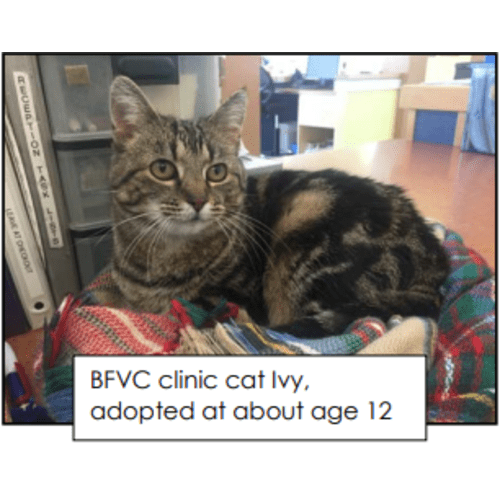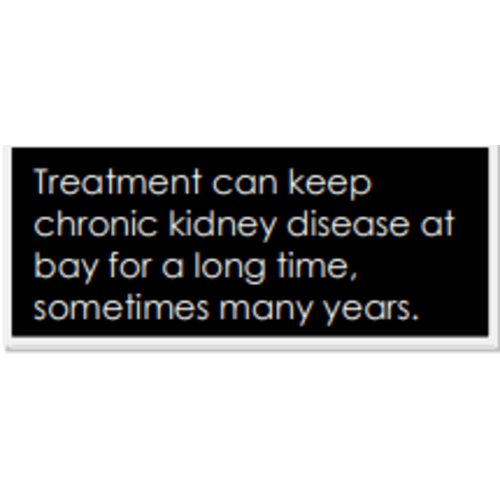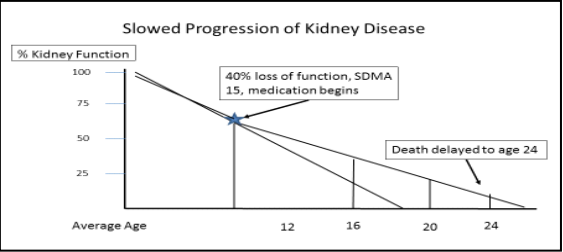Your Cat’s Golden Years
Congratulations on your success at caring for your cat for all these years!
Your pet is getting older, but the care you provide throughout its lifetime can minimize and prevent disease as he or she ages. Proper care includes periodic checkups, routine vaccinations, parasite control, dental examinations, regular exercise, and a good diet. The average indoor cat has a life expectancy of 15-18 years, and many live into their twenties nowadays.
As pets age, two types of changes occur: age related changes and pathological changes. Age related changes, such as vision and hearing loss, are normal, and develop in most animals.
These changes cannot be prevented, but we can help you and your pet to adapt. Many pathological changes or diseases can, on the other hand, be prevented or successfully treated. These include kidney, liver, gastrointestinal and thyroid conditions, arthritis and even cancer. With good care to promote health and prevent disease in senior pets, your pet can remain healthy and active well into its twilight years. Old age is not a disease, it is a stage of life. None of us would be very happy with our physicians if we went to their offices complaining about an ache or pain, lump or bump and were told, “You are just getting old, so there’s nothing we can do about that.” We can help you determine what foods, medications and procedures will improve the length and quality of your pet’s life. Your help is needed to carry out any treatment recommended.
Age-Related Sensory Changes
- Cataracts are uncommon in cats but some degree of visual impairment occurs with age.
- Hearing loss is usually gradual and may not be noticed by owners until the cat becomes completely deaf.
- Both visually and hearingimpaired cats can, and often do, function quite normally in their normal environment
- Hearing loss is not the same as senility, but caretakers may perceive it as such.
- Taste sensation is reduced in older cats and this can lead to poor appetite
- Impaired thermoregulation is another change that may occur in older cats. Provide a safe heat source for aging cats to use as needed.
Length of Life Is Not Our Only Goal
Better vaccines, nutrition, and dental care have extended many pets’ lives. Our challenge is to maintain good quality of life for these extra years. It’s not just about lifespan, it’s about “healthspan” – the length of time we can keep your cat comfortable and happy.
The importance of pets in our lives and the quality of care sought by pet owners today are significant influences on life expectancy. Dogs and cats used to be kept outdoors; then they moved indoors but slept in a basket in the kitchen. Pet owners today want the same level of health care and nutrition that they themselves enjoy, and they count on veterinarians to help preserve the precious bond they have with their pets. They share a bond with us that was unheard of fifty years ago.

Now pets share our beds, our social media and our leisure time activities. Our feline friends have their own furniture, music and clothing. These lifestyle changes have led to life expectancies that are many years longer. House cats don’t die young from infectious diseases, accidents and injuries. Instead, they suffer from an array of other diseases you need to be aware of.
Because of these societal changes, the growth of senior care products and services and the advances in senior medicine for pets has been astonishing. We now screen over 75% of the older pets we see for early signs of common diseases because our clients understand the value of wellness testing and its connection to pet health. Catching problems early allows us to do more to preserve the length and quality of a pet’s life.
The three D’s are the keys to care for senior pets – Diagnostic Testing, Diet and Dental Care.
Diagnostic Testing
So what are we looking for with our diagnostic testing? Blood and urine tests pick up kidney, liver and hormonal diseases in their beginning stages, so we can intervene early and greatly extend life expectancy with proper therapy.
Chronic kidney disease, CKD, is the most common diagnosis we make based on blood testing. CKD is a leading killer of cats but when caught early, long before symptoms appear, we can treat it effectively and add many years to your cat’s life expectancy. Do you know why you are asked to produce a urine specimen each time you visit your physician for a checkup? It is because a urinalysis is one of the least expensive but most valuable laboratory tests around.

A blood test called SDMA is included with all of our senior wellness panels. SDMA is our first early warning of kidney disease. It takes years for the symptoms of slow kidney function decline to appear. If we start treating the disease when the SDMA first starts to become elevated, usually between the ages of nine and twelve, we slow the deterioration of the kidneys and delay the onset of symptoms, which can prolong the life expectancy of your cat by several years, as the chart below shows.

Hyperthyroidism is caused by a benign tumor of the thyroid gland, which produces too much thyroid hormone. This revs up metabolism, causing weight loss, along with heart damage, high blood pressure, behavior changes and gastrointestinal symptoms. Fatal if untreated, this disease is easily managed. If it is caught before severe damage is done your cat would be expected to have a normal life expectancy. We do thyroid testing annually for cats 10 and above.
- Stool sample testing should also be done each year. Most
cat owners think that cats that don’t go outside have low risk
for intestinal parasites. This couldn’t be farther from the
truth. - Almost all cats harbor parasite larvae in their bodies
their entire lives. As with viral infections, these can flare up
and become a cause of disease as pets age.
Diabetes has become a very common disease in our feline patients, because it is associated with obesity. Because many more cats lead sedentary, indoor lifestyles nowadays, both obesity and diabetes rates have shot up over the past twenty years. As with humans, weight loss and improved diet can keep diabetes at bay in many cases. Some cats will need lifetime insulin injections. This is not as difficult as you may think, and new monitoring systems make blood sugar testing much easier. Hypertension can lead to strokes and blindness in cats, just as it can in humans. Blood
pressure monitoring is part of every senior cat exam here at Best Friends.
Cancer is a big concern for older cats and a worry for their caretakers. Happily, the most common types of cancer in felines are very treatable. To prevent cancer:
- Keep your cat at a healthy weight. Fat cells produce toxins that damage other cells, leading to cancer.
- Treat hairball vomiting seriously. Frequent hairball vomiting almost always indicates intestinal disease, which progresses slowly to cancer.
- Decrease toxin exposure. Common culprits include flea preventives and treatments containing Pyrethrin; PBDEs in canned cat foods containing fish.
- Omega three fatty acids (OM3s) protect cells from oxidative damage that leads to cancer. Supplementing fish oil from a young age reduces cancer risk.
